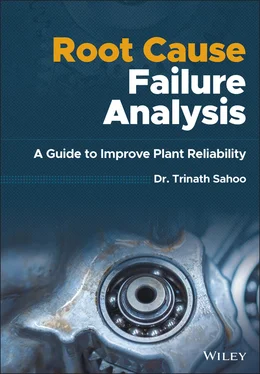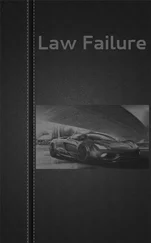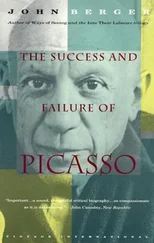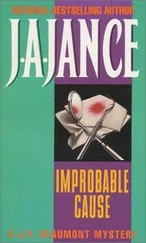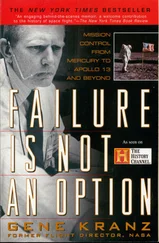Trinath Sahoo - Root Cause Failure Analysis
Здесь есть возможность читать онлайн «Trinath Sahoo - Root Cause Failure Analysis» — ознакомительный отрывок электронной книги совершенно бесплатно, а после прочтения отрывка купить полную версию. В некоторых случаях можно слушать аудио, скачать через торрент в формате fb2 и присутствует краткое содержание. Жанр: unrecognised, на английском языке. Описание произведения, (предисловие) а так же отзывы посетителей доступны на портале библиотеки ЛибКат.
- Название:Root Cause Failure Analysis
- Автор:
- Жанр:
- Год:неизвестен
- ISBN:нет данных
- Рейтинг книги:5 / 5. Голосов: 1
-
Избранное:Добавить в избранное
- Отзывы:
-
Ваша оценка:
- 100
- 1
- 2
- 3
- 4
- 5
Root Cause Failure Analysis: краткое содержание, описание и аннотация
Предлагаем к чтению аннотацию, описание, краткое содержание или предисловие (зависит от того, что написал сам автор книги «Root Cause Failure Analysis»). Если вы не нашли необходимую информацию о книге — напишите в комментариях, мы постараемся отыскать её.
Provides the knowledge and failure analysis skills necessary for preventing and investigating process equipment failures Root Cause Failure Analysis: A Guide to Improve Plant Reliability
Root Cause Failure Analysis: A Guide to Improve Plant Reliability
Root Cause Failure Analysis — читать онлайн ознакомительный отрывок
Ниже представлен текст книги, разбитый по страницам. Система сохранения места последней прочитанной страницы, позволяет с удобством читать онлайн бесплатно книгу «Root Cause Failure Analysis», без необходимости каждый раз заново искать на чём Вы остановились. Поставьте закладку, и сможете в любой момент перейти на страницу, на которой закончили чтение.
Интервал:
Закладка:
A Guide to Improve Plant Reliability
Dr. Trinath Sahoo

This edition first published 2021
© 2021 by John Wiley & Sons, Inc. All rights reserved.
No part of this publication may be reproduced, stored in a retrieval system, or transmitted, in any form or by any means, electronic, mechanical, photocopying, recording or otherwise, except as permitted by law. Advice on how to obtain permission to reuse material from this title is available at http://www.wiley.com/go/permissions.
The right of Trinath Sahoo to be identified as the author of this work has been asserted in accordance with law.
Registered Office John Wiley & Sons, Inc., 111 River Street, Hoboken, NJ 07030, USA
Editorial Office 111 River Street, Hoboken, NJ 07030, USA
For details of our global editorial offices, customer services, and more information about Wiley products visit us at www.wiley.com.
Wiley also publishes its books in a variety of electronic formats and by print‐on‐demand. Some content that appears in standard print versions of this book may not be available in other formats.
Limit of Liability/Disclaimer of Warranty In view of ongoing research, equipment modifications, changes in governmental regulations, and the constant flow of information relating to the use of experimental reagents, equipment, and devices, the reader is urged to review and evaluate the information provided in the package insert or instructions for each chemical, piece of equipment, reagent, or device for, among other things, any changes in the instructions or indication of usage and for added warnings and precautions. While the publisher and authors have used their best efforts in preparing this book, they make no representations or warranties with respect to the accuracy or completeness of the contents of this work and specifically disclaim all warranties, including without limitation any implied warranties of merchantability or fitness for a particular purpose. No warranty may be created or extended by sales representatives, written sales materials, or promotional statements for this work. This work is sold with the understanding that the publisher is not engaged in rendering professional services. The advice and strategies contained herein may not be suitable for your situation. You should consult with a professional where appropriate. Neither the publisher nor author shall be liable for any loss of profit or any other commercial damages, including but not limited to special, incidental, consequential, or other damages. The fact that an organization, website, or product is referred to in this work as a citation and/or potential source of further information does not mean that the publisher and authors endorse the information or services the organization, website, or product may provide or recommendations it may make. Further, readers should be aware that websites listed in this work may have changed or disappeared between when this work was written and when it is read. Neither the publisher nor authors shall be liable for any loss of profit or any other commercial damages, including but not limited to special, incidental, consequential, or other damages.
For general information on our other products and services or for technical support, please contact our Customer Care Department within the United States at (800) 762‐2974, outside the United States at (317) 572‐3993 or fax (317) 572‐4002.
Wiley also publishes its books in a variety of electronic formats. Some content that appears in print may not be available in electronic formats. For more information about Wiley products, visit our web site at www.wiley.com.
Library of Congress Cataloging‐in‐Publication Data
Names: Sahoo, Trinath, author.
Title: Root cause failure analysis : a guide to improve plant reliability / Trinath Sahoo.
Description: Hoboken, New Jersey : Wiley, 2021. | Includes bibliographical references and index.
Identifiers: LCCN 2020053092 (print) | LCCN 2020053093 (ebook) | ISBN 9781119615545 (hardback) | ISBN 9781119615590 (adobe pdf) | ISBN 9781119615613 (epub)
Subjects: LCSH: Root cause analysis. | Piping. | Industrial equipment.
Classification: LCC TA169.55.R66 S25 2021 (print) | LCC TA169.55.R66 (ebook) | DDC 658.2–dc23
LC record available at https://lccn.loc.gov/2020053092LC ebook record available at https://lccn.loc.gov/2020053093
Cover Design: Wiley
Cover Images: © ch123/Shutterstock, Yakov Oskanov/Shutterstock
Preface
Process industries are home to a huge number of machines, piping, structures, most of them critical to the industry’s mission. Failure of these items can cause loss of life, unscheduled shutdowns, increased maintenance and repair costs, and damaging litigation disputes. Experience shows that all too often, process machinery problems are never defined sufficiently; they are merely “solved” to “get back on stream.” Production pressures often override the need to analyze a situation thoroughly, and the problem and its underlying cause come back and haunt us later. Equipment downtime and component failure risk can be reduced only if potential problems are anticipated and avoided. To prevent future recurrence of the problem, it is essential to carry out an investigation aimed at detecting the root cause of failure.
The ability to identify this weakest link and propose remedial measures is the key for a successful failure analysis investigation. This requires a multidisciplinary approach, which forms the basis of this book. The results of the investigation can also be used as the basis for insurance claims, for marketing purposes, and to develop new materials or improve the properties of existing ones.
The objective of this book is to help anyone involved with machinery reliability, be it in the design of new plants or the maintenance and operation of existing ones, to understand why the process machine fails, so some preventive measures can be taken to avoid another failure of the same kind.
An important feature of this book is that it not only demonstrates the methodology for conducting a successful failure analysis investigation, but also provides the necessary background.
The book is divided in two parts:
1 The first part discusses the benefit of failure analysis, including some definitions and examples. Here, we examine the failure analysis procedure, including some approaches suitable for different types of problems. We also look at how plant‐wide failure prevention efforts should be conducted, including a discussion about the importance of the role of the top management in the prevention of failure.
2 In the second part, different types of failure mechanisms that affect process equipment are discussed with several examples of bearings, seals, and other components’ failures.
Because it is simply impossible to deal with every conceivable type of failure, this book is structured to teach failure identification and analysis methods that can be applied to virtually all problem situations that might arise.
Trinath Sahoo
About the Author

Trinath Sahoo, Ph.D., is the chief general manager at M/S Indian Oil Corporation Ltd. Dr. Sahoo has 30 years of experience in various fields such as engineering design, project management, asset management, maintenance management, lubrication, and reliability. He has published many papers in journals like Hydrocarbon Processing, Chemical Engineering, Chemical Engineering Progress, and World Pumps . Some of his articles were adjudged best articles and published as the cover page story in the magazines. He has also spoken in many international conferences. He was the convener for reliability enhancement projects for different refinery and petrochemical sites of M/S Indian Oil Corporation Ltd. Dr. Sahoo is the author of bestselling book Process Plants: Shutdown and Turnaround Management . He holds a Ph.D. degree from Indian Institute of Technology (ISM), Dhanbad, Jharkhand, India.
Читать дальшеИнтервал:
Закладка:
Похожие книги на «Root Cause Failure Analysis»
Представляем Вашему вниманию похожие книги на «Root Cause Failure Analysis» списком для выбора. Мы отобрали схожую по названию и смыслу литературу в надежде предоставить читателям больше вариантов отыскать новые, интересные, ещё непрочитанные произведения.
Обсуждение, отзывы о книге «Root Cause Failure Analysis» и просто собственные мнения читателей. Оставьте ваши комментарии, напишите, что Вы думаете о произведении, его смысле или главных героях. Укажите что конкретно понравилось, а что нет, и почему Вы так считаете.
